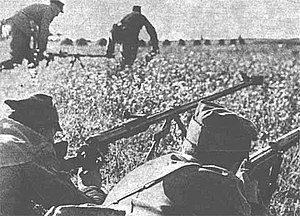PTRD-41
| PTRD-41 | |
|---|---|
 Polish Army soldiers with PTRDs in Siedlce, 1944 | |
| Type | Anti-tank rifle |
| Place of origin | Soviet Union |
| Service history | |
| In service | 1941–1960s (Retired USSR) |
| Used by | Soviet Union, North Korea, China |
| Wars | World War II Korean War Chinese Civil War War in Donbass[citation needed] |
| Production history | |
| Designer | Vasily Degtyaryov |
| Designed | 1941 |
| Manufacturer | Degtyaryov plant |
| Produced | 1941–45 |
| Specifications | |
| Mass | 17.3 kg (38.1 lbs) |
| Length | 2,020 mm (79.5 in.) |
| Barrel length | 1,350 mm (53.1 in.) |
| Crew | 2 |
| Cartridge | 14.5×114mm (B-32, BS-41[1]) |
| Action | Single-fire |
| Rate of fire | Single shot,user dependent |
| Muzzle velocity | 1,114 m/s (3,655 ft/s) |
| Effective firing range | 300 m (on personnel targets, dispersion of bullets on 300 meters 0,36 m[2]) |
| Maximum firing range | 1,000 m[3] |
| Feed system | Single shot, no magazine |
| Sights | Front post, rear notch |
The PTRD-41 (Shortened from Russian, ProtivoTankovoye Ruzhyo Degtyaryova;Противотанковое однозарядное ружьё системы Дегтярёва образца 1941 года;"Degtyaryov Anti-Tank Rifle") was an anti-tank rifle produced and used from early 1941 by the Soviet Red Army during World War II. It was a single-shot weapon which fired a 14.5×114mm round. Although unable to penetrate the frontal armor of German tanks, it could penetrate the thinner sides of early-war German tanks as well as thinly armored self-propelled guns.
History
In 1939 the USSR captured several hundred Polish Model 35 anti-tank rifles, which proved effective in the September Campaign when Poland was invaded by Germany. Vasily Degtyaryov copied its lock and several features of the German Panzerbüchse 38 when hasty construction of an anti-tank rifle was ordered in July 1941.[citation needed]
The PTRD and the similar PTRS-41 were the only individual anti-tank weapon available to the Red Army in numbers upon the outbreak of the war with Germany. The 14.5 mm armor-piercing bullet had a muzzle velocity of 1,012 m/s (3,320 ft/s). It could penetrate an armor plate up to 35 to 40mm (40mm with tungsten ammunition) thick at a distance of 100 meters at 0 degrees. During the initial invasion, and indeed throughout the war, most German tanks had side armor thinner than 40mm (Panzer I and Panzer II: 13-20mm, Panzer III and Panzer IV series: 30mm, Panzer V Panther (combat debut mid-1943): 40-50mm). However, due to the high velocity and small size of the round, it had a very high chance of shattering or utterly failing against armor it should have penetrated, especially if the target was struck at an oblique angle.
Due to the obsolescence and inadequate ability against tanks, PTRD users were instructed to attempt to shoot view ports rather than actually try to penetrate the vehicles' armour. Despite the good range of fire, this tactic was quickly found ineffective due to the absence of telescopic sights: the simple mechanical (iron) ones did not allow for proper aiming at the required distances. The muzzle brake, however effective, kicked up a very visible cloud of dust or snow and debris and served to give away the position of the PTRD team. After poor results against the enemy tanks the PTRD and PTRS were finally relegated to anti-materiel duty in 1943[citation needed] as they were still effective against lesser armored vehicles such as armored half-tracks, armored cars and unarmored vehicles.

The PTRD suffered from numerous flaws; the most notable are the lack of penetration versus enemy vehicles and inability to aim accurately with a telescopic sight, which frustrated PTRD teams, its size and weight which hampered its mobility and deployment, and its immense muzzle blast which gave away the unit's firing position. The PTRD was eventually replaced by the RPG series of anti-tank rocket launchers.
After World War II the PTRD was also used extensively by North Korean and Chinese armed forces in the Korean War. During this war, William Brophy, an American Army Ordnance officer, mounted a .50 BMG barrel to a captured PTRD to examine the effectiveness of long-range shooting. The weapon proved effective out to 2,000 yards.[4]
See also
References
- ^ Manual on Small Arms (NSD-42) Military Publishing House Moscow 1942
- ^ Manual on Small Arms (NSD-42) Military Publishing House Moscow 1942
- ^ Manual on Small Arms (NSD-42) Military Publishing House Moscow 1942
- ^ "Hard Target Interdiction" (PDF). http://www.remingtonmilitary.com/. Remington Arms. 2005. Archived from the original (PDF) on 20 March 2006. Retrieved 13 December 2008.
{{cite web}}: External link in|work=
- Koll, Christian (2009). Soviet Cannon - A Comprehensive Study of Soviet Arms and Ammunition in Calibres 12.7mm to 57mm. Austria: Koll. p. 91. ISBN 978-3-200-01445-9.
{{cite book}}: Cite has empty unknown parameter:|coauthors=(help)
